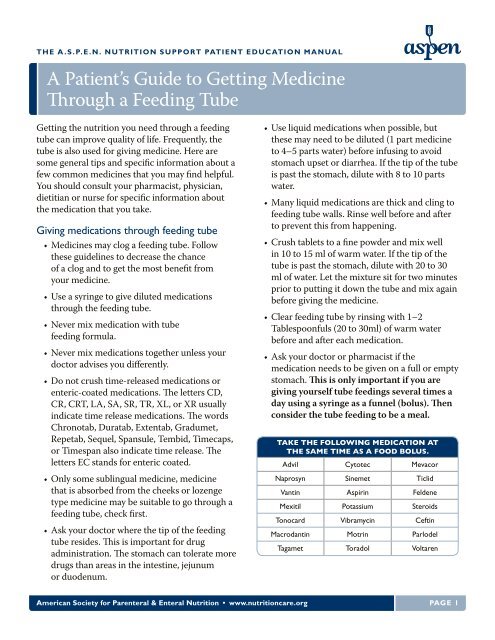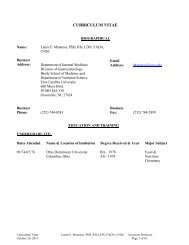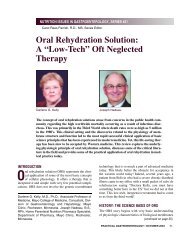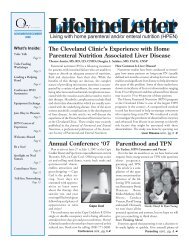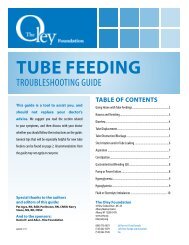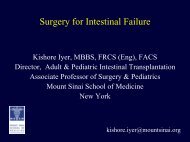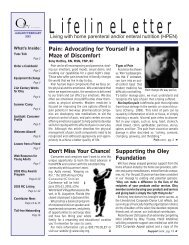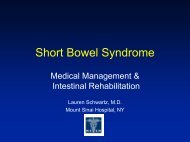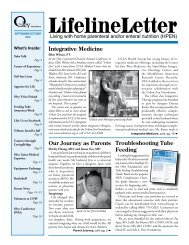A Patient's Guide to Getting Medicine Through a Feeding Tube
A Patient's Guide to Getting Medicine Through a Feeding Tube
A Patient's Guide to Getting Medicine Through a Feeding Tube
You also want an ePaper? Increase the reach of your titles
YUMPU automatically turns print PDFs into web optimized ePapers that Google loves.
The A.S.P.E.N. Nutrition Support Patient Education ManualA Patient’s <strong>Guide</strong> <strong>to</strong> <strong>Getting</strong> <strong>Medicine</strong><strong>Through</strong> a <strong>Feeding</strong> <strong>Tube</strong><strong>Getting</strong> the nutrition you need through a feedingtube can improve quality of life. Frequently, thetube is also used for giving medicine. Here aresome general tips and specific information about afew common medicines that you may find helpful.You should consult your pharmacist, physician,dietitian or nurse for specific information aboutthe medication that you take.Giving medications through feeding tube• <strong>Medicine</strong>s may clog a feeding tube. Followthese guidelines <strong>to</strong> decrease the chanceof a clog and <strong>to</strong> get the most benefit fromyour medicine.• Use a syringe <strong>to</strong> give diluted medicationsthrough the feeding tube.• Never mix medication with tubefeeding formula.• Never mix medications <strong>to</strong>gether unless yourdoc<strong>to</strong>r advises you differently.• Do not crush time-released medications orenteric-coated medications. The letters CD,CR, CRT, LA, SA, SR, TR, XL, or XR usuallyindicate time release medications. The wordsChronotab, Duratab, Extentab, Gradumet,Repetab, Sequel, Spansule, Tembid, Timecaps,or Timespan also indicate time release. Theletters EC stands for enteric coated.• Only some sublingual medicine, medicinethat is absorbed from the cheeks or lozengetype medicine may be suitable <strong>to</strong> go through afeeding tube, check first.• Ask your doc<strong>to</strong>r where the tip of the feedingtube resides. This is important for drugadministration. The s<strong>to</strong>mach can <strong>to</strong>lerate moredrugs than areas in the intestine, jejunumor duodenum.• Use liquid medications when possible, butthese may need <strong>to</strong> be diluted (1 part medicine<strong>to</strong> 4–5 parts water) before infusing <strong>to</strong> avoids<strong>to</strong>mach upset or diarrhea. If the tip of the tubeis past the s<strong>to</strong>mach, dilute with 8 <strong>to</strong> 10 partswater.• Many liquid medications are thick and cling <strong>to</strong>feeding tube walls. Rinse well before and after<strong>to</strong> prevent this from happening.• Crush tablets <strong>to</strong> a fine powder and mix wellin 10 <strong>to</strong> 15 ml of warm water. If the tip of thetube is past the s<strong>to</strong>mach, dilute with 20 <strong>to</strong> 30ml of water. Let the mixture sit for two minutesprior <strong>to</strong> putting it down the tube and mix againbefore giving the medicine.• Clear feeding tube by rinsing with 1–2Tablespoonfuls (20 <strong>to</strong> 30ml) of warm waterbefore and after each medication.• Ask your doc<strong>to</strong>r or pharmacist if themedication needs <strong>to</strong> be given on a full or emptys<strong>to</strong>mach. This is only important if you aregiving yourself tube feedings several times aday using a syringe as a funnel (bolus). Thenconsider the tube feeding <strong>to</strong> be a meal.Take the following medication atthe same time as a food bolus.Advil Cy<strong>to</strong>tec MevacorNaprosyn Sinemet TiclidVantin Aspirin FeldeneMexitil Potassium SteroidsTonocard Vibramycin CeftinMacrodantin Motrin ParlodelTagamet Toradol VoltarenAmerican Society for Parenteral & Enteral Nutrition • www.nutritioncare.org Page 1
A Patient’s <strong>Guide</strong> <strong>to</strong> <strong>Getting</strong> <strong>Medicine</strong>, Cont.Take the following medicationsan hour before a food bolus.Bumex Lorabid ZithromaxCarafate Hismanol TetracylineDyazide Lasix FosamaxErythrocin(E.stearate)Recommendations for specific medicationsand tube feeding (tf)• If holding tube feeding for medication,check with the dietitian, physician, nurseor pharmacist about increasing your tubefeeding rate <strong>to</strong> get all your nutrition.Cipro (ciprofloxacin)• Administration of this medication througha feeding tube, using a syringe, may producedifferent results than taking it by mouth.• Rinse your feeding tube well before and afteradministration of ciprofloxacin.• Do not allow drug <strong>to</strong> have contact with othermedications or tube feeding.Dilantin (pheny<strong>to</strong>in)Penicillin &derivatives• Do not use opened capsule.Isoniazide (INH)Ciprofloxacin• Decreased absorption with enteral feeding mayresult in decreased serum levels (50–75%).• Your health provider needs <strong>to</strong> check druglevels. They may ask you <strong>to</strong> hold enteral feedingfor 1–2 hours before and after pheny<strong>to</strong>in oradjust your dose.• If you have a jejunos<strong>to</strong>my tube, your pheny<strong>to</strong>inmay be administered as a suspension.Tegre<strong>to</strong>l (carbamazepine)• Because you have a feeding tube, your dose ofthis medication may need <strong>to</strong> be adjusted morefrequently. Especially if you have a jejunos<strong>to</strong>mytube.Coumadin Tablets (Warfarin)• Warfarin requires careful and consistentmedication administration <strong>to</strong> maintainlevels. Moni<strong>to</strong>ring of blood clotting is alsonecessary. It is important that the method ofadministration is the same every time <strong>to</strong> keepthe amount absorbed the same. Small changesin amount of medication absorbed can producedecreased benefit from the medication andincrease side effects.• Warfarin is most often prescribed as a tabletand must be crushed and mixed in<strong>to</strong> slurry foradministration in<strong>to</strong> a feeding tube.• It is extremely important <strong>to</strong> flush yourfeeding tube following warfarin <strong>to</strong> minimizeinteraction with the tube. Special care isneeded <strong>to</strong> reduce this interaction.• Some experts advise holding nutritionformulas for 1–2 hours before and afterwarfarin <strong>to</strong> avoid interactions. Not all expertsagree in the nature of the interaction or theneed <strong>to</strong> hold nutrition. In many cases adequatedilution and rinsing will avoid this interaction.Synthroid, Levothroid (levothyroxine)• An animal study suggested that protein intakealters serum levels of levothyroxine. Yourdoc<strong>to</strong>r should check your thyroid functionperiodically.There may be interactions and incompatibilitiesbetween your prescribed medications and anyherbal products, over the counter medicationsor nutrition supplements that you are taking.Check with your physician or pharmacist prior<strong>to</strong> continuing <strong>to</strong> use them.Developed by Eric H. Frankel, MSE, PharmD, BCSNP West Texas Clinical Pharmacy Associates, Inc., Lubbock, TXand Mark G. Klang, MS, RPh, BCNSP Sloan-Kettering Institute New York, NYAmerican Society for Parenteral & Enteral Nutrition • www.nutritioncare.org Page 2 of 2


